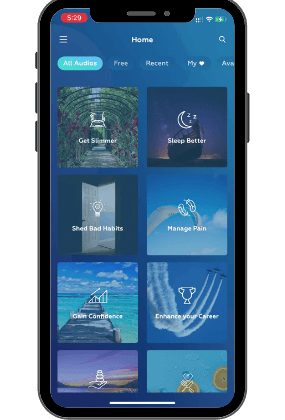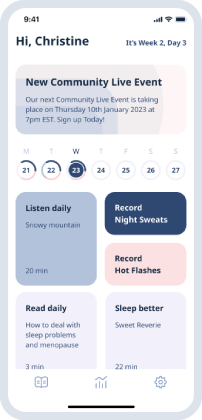
Postmenopause Unveiled: Understanding and Managing the Change

Self-Confidence Apps: Transform Your Life in Just a Few Minutes a Day
Table of Contents
- Understanding Guided Imagery Therapy
- How Guided Visualizations Work
- Guided Imagery Techniques
- Benefits of Guided Visualizations for Health and Wellness
- Better Mental Health through Mind-Body Connection
- Guided Imagery and Chronic Conditions
- Best Practices for Incorporating Guided Visualizations into Daily Routine
- Enjoying Guided Imagery with UpNow Self-Hypnosis
In the quest for enhanced well-being and optimal health, we often overlook the power tucked away in our minds. One such potent tool is guided imagery, a powerful technique that harnesses the mind’s capacity to stimulate relaxation, inspire change, and promote healing.
Incorporating mental imagery into daily life has been made simpler with resources like UpNow’s self-hypnosis programs, which offer guided imagery exercises designed to tap into your subconscious, helping you visualize and actualize a healthier, happier self. Join us as we delve into the transformative world of guided visualizations and explore how they can be your ally in achieving improved health and wellness.
Understanding Guided Imagery Therapy
Guided imagery, often known as guided imagination, is a technique that involves using the power of your mind to influence your physical and emotional state. It’s a type of focused relaxation that provides a unique blend of physical relaxation and active visualization conducted by a hypnotherapist or through a pre-recorded session.
The process involves visualizing specific scenarios or environments that are calming and relaxing for the individual. The idea is to take the mind on a sensory journey filled with soothing images, sounds, smells, and even tastes to encourage relaxation and stress relief.
Many can remember paying attention to the imagery in a guided meditation, and many more have used this effective therapeutic technique for decades, if not centuries, in self-hypnosis.
How Guided Visualizations Work
Guided visualization works under the principle that the mind and body are interconnected. Our thoughts can influence our physical state and vice versa. When we visualize peaceful and positive experiences, we use the language of the subconscious level. Our body responds by releasing chemicals that generate feelings of positivity and calm.
Guided Imagery Techniques
Many types of guided imagery can bring you to a relaxing scene.
Close your eyes, take a few deep breaths, and prepare to let your mind wander to places of tranquillity and peace.
You can imagine a world where you can control your emotions, calm your mind, and reduce stress with just the power of your imagination… Welcome to the practice of guided visualization, an immersive experience harnessing the power of your mind to promote relaxation, mindfulness, and overall mental well-being.
Nature-Based Guided Imagery
Nature-based guided imagery is a powerful tool for calming the mind and grounding yourself. Imagine yourself in a serene forest, the sun filtering through the leaves, the sound of a gentle stream nearby. Feel the cool breeze against your skin, and smell the earthy scent of the forest floor.
If you prefer grass or beaches, you can adapt the visualization with a peaceful meadow or tropical beach. This type of visualization connects you with nature, promoting a sense of peace and grounding, and reducing stress and anxiety.
Progressive Muscle Relaxation and Visualization
The progressive relaxation technique involves mentally scanning your body and releasing tension in each muscle group, one at a time. Imagine a warm, soothing light travelling from the top of your head, down your spine, and spreading to every part of your body. As the light touches each area, feel the muscles relax and release all tension. This technique helps reduce physical stress symptoms and promotes a deep state of relaxation.
Affirmative Visualization
Affirmative visualization focuses on positive mental images and affirmations to boost self-esteem and confidence. Visualize yourself achieving a goal or overcoming a challenge. Hear the words, “I am capable, I am strong, I can handle this.” This method cultivates a positive mindset, boosts motivation, and encourages resilience.
Benefits of Guided Visualizations for Health and Wellness
Guided imagery has gained recognition in mental health for its myriad benefits. This mindfulness practice involves creating vivid mental images, such as a landscape, a calming scenario, or desired outcome. By doing so, guided imagery positively influences our mental and physical states. Let’s delve into some of the key benefits of this transformative practice.

Better Mental Health through Mind-Body Connection
Enhanced Cognitive Function
Guided visualization can significantly improve cognitive function. A 2018 study published in the journal Cognitive Research: Principles and Implications found that individuals who practiced guided imagery demonstrated improved concentration and problem-solving skills.
This is because visualizing scenarios engage the same parts of the brain that are activated when physically performing the task, thereby strengthening neural connections.
Relaxation Technique Through a Guided Image
Guided imagery relaxation therapy is powerful for achieving deep relaxation and stress relief. This technique encourages individuals to visualize calming and peaceful images or scenarios, engaging all the senses to create a holistic relaxation experience.
Research has shown that this form of therapy can also have physiological benefits, such as reducing blood pressure.
Research suggests that guided imagery relaxation therapy can significantly reduce blood pressure levels. This response is likely due to a cascade of improvements in our body: when we feel relaxed, our heart rate slows, and our blood pressure decreases.
Therefore, guided imagery relaxation therapy can be an effective tool not only for mental relaxation but also for promoting overall physical health. In the next sections, we will tackle precise applications for health.
Anxiety and Stress Management
One of the most well-documented benefits of guided imagery is its ability to reduce stress and anxiety. By visualizing calming scenarios, individuals can shift their focus from sources of stress, promoting relaxation and reducing anxiety levels.
A study published in Frontiers in Psychology found that participants who used nature-based guided imagery experienced significant reductions in anxiety.
Visual mental imagery techniques can apply to different types of state anxieties, i.e. anxiety tied to a particular event. For example, preoperative anxiety happens before surgery because people might dread recovery. Exam stress is another state anxiety creating anxious feelings in students.
Chronic Pain Management
For those living with chronic pain, guided imagery can be a powerful pain management tool. Visualizing oneself in a pain-free state can help alter pain perceptions and increase tolerance to discomfort.
According to research published in Pain Management Nursing, patients suffering from chronic pain conditions reported decreased pain severity after incorporating guided imagery into their treatment plan.
Hypnotherapy integrates this pain-reducing intervention in addition to other techniques to manage pain.
Improves Sleep
Postive imagery can be an effective tool for improving sleep quality. Creating a mental state of relaxation and tranquility can help prepare the body for restful sleep.
A study published in the Critical Care Nurse publication found that individuals who practiced guided imagery reported better sleep and less insomnia.
This practice can be particularly beneficial for those suffering from insomnia or other sleep disorders, offering a natural and non-pharmacological approach to improving sleep.

Reduced Depression Symptoms
Depression is a complex condition that can deeply affect an individual’s quality of life. Guided imagery can serve as a supportive tool in managing depression symptoms. By visualizing positive experiences or outcomes, individuals can foster a more optimistic mindset, which is often challenged by depression.
Research published in the Complementary Therapies in Clinical Practice publication found that participants who incorporated guided imagery into their treatment plan experienced a significant reduction in depressive symptoms. While not a standalone treatment for depression, guided imagery can complement traditional therapies such as hypnotherapy, providing individuals with an additional resource in their mental health journey.
Bolstering Overall Well-being
Beyond these specific benefits, guided imagery can enhance overall well-being by increasing relaxation and fostering greater self-awareness. This technique allows individuals to connect with their inner selves, understand their emotions better, and cultivate a more positive outlook on life.
In achieving your specific wellness and health goals, guided imagery can be a valuable addition to your toolkit. Whether aiming to reduce stress, manage pain, or enhance cognitive function, this practice offers a powerful way to harness your mind’s potential and influence your physical reality.
In conclusion, guided imagery is not just a mental exercise—it’s a holistic approach to wellness that can bring about profound changes in mind and body. By incorporating this practice into your routine, you can actively shape your health, well-being, and ultimately, your life.
Guided Imagery and Chronic Conditions
Living with a chronic condition can be challenging, bringing physical discomfort and emotional stress. Guided imagery can offer a valuable tool to help manage these conditions and improve the quality of life.
One key benefit of guided visualizations is their ability to reduce stress, which is often heightened in individuals with chronic illnesses. By creating mental images of serene and calming scenarios, individuals can divert their focus from their health issues, thus lowering stress levels and promoting relaxation.
For advanced cancer patients, guided imagery can be particularly beneficial. Many studies reported that cancer patients who practiced guided visualization experienced a significant reduction in stress and anxiety symptoms.
The practice can also help patients cope with the emotional distress associated with their diagnosis and treatment, fostering a sense of calm and positivity amid challenging circumstances.
Additionally, guided visualization has shown promise in managing chronic migraine headaches. In a study featured in the journal Music Therapy, migraine sufferers who used guided imagery and music reported a decrease in the frequency of visits to the clinic and severity of their headaches. By visualizing themselves in a pain-free state, they could influence their perception of pain and enhance their pain management strategies.
In conclusion, guided imagery can play a crucial role in managing chronic conditions. This practice can help reduce stress, aid in emotional coping for cancer patients, or alleviate migraine headaches by addressing both physical symptoms and emotional well-being.
Best Practices for Incorporating Guided Visualizations into Daily Routine
Incorporating guided imagery into your daily routine can be simple.
Find a quiet place. Start by choosing a peaceful place to visualize. Take deep breaths, allowing your body to relax as you breathe slowly and deeply.
Engage your five senses in the visualization process, imagining your scene’s sights, sounds, smells, tastes, and physical sensations. As you immerse yourself in this mental landscape, continue breathing deeply to maintain a state of relaxation.
Enjoying Guided Imagery with UpNow Self-Hypnosis
Incorporating guided imagery into your wellness routine has never been easier, thanks to UpNow Self-Hypnosis. Utilizing comprehensive guided imagery scripts embedded into its self-hypnosis program, UpNow equips you with the tools and techniques to effectively harness your mind’s power.
Practicing guided imagery is made even more accessible with UpNow’s audio recordings. By following along with the audio recording, you can immerse yourself in the imagery and reap the myriad benefits this guided imagery training offers.
This practice is more than just a relaxation tool—it’s a powerful ally in boosting your overall health and wellness. Regularly practicing guided imagery with UpNow Self-Hypnosis can unlock your mind’s potential and enhance your physical and mental well-being.
Ready to embark on your guided imagery training journey? Download UpNow self-hypnosis today and take the first step towards a healthier, more balanced you. It’s a personal journey of discovery, relaxation, and mindfulness. Happy visualizing!
UpNow Health only uses high-quality sources, including peer-reviewed articles, to support the facts within our articles. Experts review all our articles to ensure our content is accurate, helpful, and trustworthy.
1. Padilla, L. M., Creem-Regehr, S. H., Hegarty, M., & Stefanucci, J. K. (2018). Decision making with visualizations: a cognitive framework across disciplines. Cognitive research: principles and implications, 3, 29. https://doi.org/10.1186/s41235-018-0120-9
2. Velikova, S., Sjaaheim, H., & Nordtug, B. (2017). Can the Psycho-Emotional State be Optimized by Regular Use of Positive Imagery?, Psychological and Electroencephalographic Study of Self-Guided Training. Frontiers in human neuroscience, 10, 664. https://doi.org/10.3389/fnhum.2016.00664
3. Eller L. S. (1999). Guided imagery interventions for symptom management. Annual review of nursing research, 17, 57–84. Link
4. Álvarez-García, C., & Yaban, Z. Ş. (2020). The effects of preoperative guided imagery interventions on preoperative anxiety and postoperative pain: A meta-analysis. Complementary therapies in clinical practice, 38, 101077. https://doi.org/10.1016/j.ctcp.2019.101077
5. Aghakhani, N., Faraji, N., Alinejad, V., Goli, R., & Kazemzadeh, J. (2022). The effect of guided imagery on the quality & severity of pain & pain-related anxiety associated with dressing changes in burn patient: A randomized controlled trial. Burns : journal of the International Society for Burn Injuries, 48(6), 1331–1339. https://doi.org/10.1016/j.burns.2021.11.020
6. Standford Healthcare. Guided Imagery. Link.
7. National Centre for Complementary and Integrative Health. Relaxation Techniques: What You Need To Know. Link.
8. Nguyen, J., & Brymer, E. (2018). Nature-Based Guided Imagery as an Intervention for State Anxiety. Frontiers in psychology, 9, 1858. https://doi.org/10.3389/fpsyg.2018.01858
9. Beizaee, Y., Rejeh, N., Heravi-Karimooi, M., Tadrisi, S. D., Griffiths, P., & Vaismoradi, M. The effect of guided imagery on anxiety, depression & vital signs in patients on hemodialysis. Complementary therapies in clinical practice, 33, 184–190. https://doi.org/10.1016/j.ctcp.2018.10.008
10. Giacobbi, P. R., Jr, Stabler, M. E., Stewart, J., Jaeschke, A. M., Siebert, J. L., & Kelley, G. A. (2015). Guided Imagery for Arthritis & Other Rheumatic Diseases: A Systematic Review of Randomized Controlled Trials. Pain management nursing : official journal of the American Society of Pain Management Nurses. 16(5), 792–803. https://doi.org/10.1016/j.pmn.2015.01.003
11. Gail Elliott Patricolo, Amanda LaVoie, Barbara Slavin, Nancy L. Richards, Deborah Jagow, Karen Armstrong; Beneficial Effects of Guided Imagery or Clinical Massage on the Status of Patients in a Progressive Care Unit. Crit Care Nurse 1 February 2017; 37 (1): 62–69. doi: https://doi.org/10.4037/ccn2017282
12. Roffe, L., Schmidt, K., & Ernst, E. (2005). A systematic review of guided imagery as an adjuvant cancer therapy. Psycho-oncology, 14(8), 607–617. https://doi.org/10.1002/pon.889
13. Lee, M. H., Kim, D. H., & Yu, H. S. (2013). The effect of guided imagery on stress & fatigue in patients with thyroid cancer undergoing radioactive iodine therapy. Evidence-based complementary and alternative medicine : eCAM, 2013, 130324. https://doi.org/10.1155/2013/130324
14. Maria Eleni Smyrnioti, MA, PgDip, FAMI and others, Guided Imagery and Music in Patients With Chronic Daily Headache: A Pilot Study, Music Therapy Perspectives, Volume 41, Issue 1, Spring 2023, Pages e13–e20, https://doi.org/10.1093/mtp/miac025













